Interview with Joy Glen, Audiologist and National Training Director, ReSound
Topic: Azure and Miss America 2005
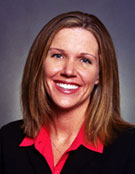 Paul Dybala: Hello everybody. This is Dr. Paul Dybala with Audiology Online. Today, I am meeting with Joy Glen from ReSound, and we are talking about a brand new product that they have just released: Azure. Joy, first I just want to say thanks for taking time to meet with me today.
Paul Dybala: Hello everybody. This is Dr. Paul Dybala with Audiology Online. Today, I am meeting with Joy Glen from ReSound, and we are talking about a brand new product that they have just released: Azure. Joy, first I just want to say thanks for taking time to meet with me today. Joy Glen: Well, thank you, Paul.
Dybala: Joy, could you give us a little bit about your professional background, and what you do for ReSound?
Glen: I am an audiologist working as the National Training Director for ReSound. I handle all the continuing education programs that we do all over the country, in addition to some product management and public activities.
Dybala: Well, ReSound recently released a new hearing aid called "Azure". Could you give us a quick general overview of Azure and what makes it different?
Glen: Absolutely! I think the most exciting thing about Azure is that we reinvented directionality. We've come up with a brand new philosophy and fitting strategy for helping hearing aid patients with Natural Directionality, and that's never been done before.
Dybala: What's really interesting about this is that it's almost counter-intuitive the way that you have implemented what you have termed "Natural Directionality". For the readers who may not be familiar with this idea, can you go into what actually happens inside an Azure hearing aid?
Glen: Well, the device takes the impaired peripheral system and it supplies it with directionality; however, it also works directly with the unimpaired central system. It takes all the good things, the residual processes that are still going on in the brain as well as patients' natural ability to achieve binaural squelch, and spatial separation. These abilities are not impaired centrally, so the hearing aid works with those binaural effects in addition to the actual impaired peripheral system. The counter-intuitive part is that you are performing what we know in the field to be an asymmetrical fitting.
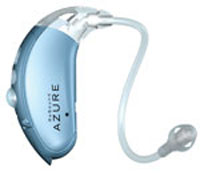
Dybala: So one of the hearing aids is going into directional mode or parts of directional mode and one is not. Correct?
Glen: Correct. There is an algorithm that is a key component of this in the new Azure software; it's called the decision tree, and it performs as an analysis using all the audiometric information. You know, sometimes pure-tone thresholds of the right ear will be better than the left, but the speech results might be better for the left ear than the right. If that is under consideration, then the software algorithm determines which ear will be the Focus Ear and which ear will be the Monitor Ear. It will then do a couple of things: it will assign one of the hearing aids to be omnidirectional and one of the hearing aids to act in a directional mode. Then it takes the two ears, connected as a biologic cooperative system and integrates natural binaural components. That produces better information for the auditory system so that the patient is always balanced.
What happens is that, for the first time ever, people don't get the "tunnel hearing" that typically happens with traditional directional systems, where they can only hear the person in front of them. Previously, we would expect that a patient might miss the person on the side of them in a restaurant or, in their car while trying to listen to a child talking in the backseat of the car.
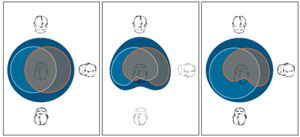
From Figure 2 in ReSound's publication "ReSound Azure: The Audiology Background" - Speakers at different locations are audible with a bilateral omni-directional fitting (left panel), but not necessarily intelligible. Bilateral directional microphone fittings decrease audibility for speakers beside and behind the listener (middle panel). With an asymmetric fitting (right panel), speakers from different directions are audible, and the listener can shift his attention to any one of them.
For the Azure patient, the listening ability from the front would be completely preserved but they would be able to hear sounds coming from the side also. If they were in a restaurant, and somebody said something from the side or if they were in the car situation, they wouldn't miss a thing. The beauty of this system is that this is all going on in the first program. There are no buttons to push, there is no automatic switching. It's just always on, it's always happening!
Dybala: You mentioned this was research based. Could you go into more information on that?
Glen: The field trials were conducted by Dr. Brian Walden and his colleagues from Walter Reed Army Medical Center (Cord, M.T., Walden, B.E., Surr, R.K. & Dittberner, A.B., 2007). They compiled 1,612 current existing hearing aid patient listening reports from patients who had directional hearing aids and were dissatisfied with them. Some of the aids had manual switching, some were automatic switching, but the bottom line was that they were not happy with the directional component. So, the research group tested Natural Directionality on them. Two major findings from those studies were that 92% of those patients reported the same speech intelligibility that they always thought they had. About 8% of the group thought it was even better, and we account for that by noting that those people are the ones that were in auto-switching programs, or had buttons. So for the most part, intelligibility is completely preserved, and sometimes you get even better speech intelligibility.
The best news is that there was a statically significant preference for Natural Directionality's ease-of-use. They found it to be comfortable, they didn't have to do anything, they felt natural, and they didn't feel like they had tunnel hearing. They were able to hear everything they needed to hear, such as speech coming from the front, but they were also able to get all that peripheral awareness coming from the sides and behind.
So, it's Natural Directionality. It's the first hearing aid that tests well in a contrived laboratory with KEMAR, but it gives incredible benefits in the real world also.
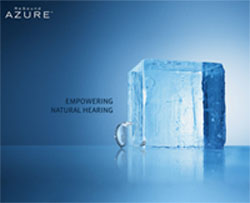
Dybala: Another feature of Azure is a sophisticated classifier algorithm, the Environmental Optimizer. Tell us more about this feature.
Glen: We paid attention to research, and really thought about patient preference. What one person thinks is loud is not what another person thinks is loud. The beauty of the Azure's Environmental Optimizer is that it reads the environment, and it classifies sound into seven different categories: quiet, soft speech, loud speech, moderate speech in noise, loud speech in noise, moderate noise, and loud noise.
I think that's exciting, because we have the only hearing aid now that can classify sounds into seven different environments. What we know is that in the real world, it's not a small-medium-large kind of a noisy world. There are so many different environments; the differences are significant.
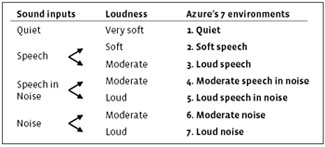
Azure's seven environmental categories.
So what the hearing aid does is apply volume adjustments in those seven different environments. If the person likes the hearing aid, but they're still looking for help on, let's say, loud noise, then they can have that environment set to their personal preference level. So it's putting the patient in control.
There's a learning component to this hearing aid also. If someone does have a volume control, it learns their preferences with what they're doing with the volume control, and it will automatically start to make adjustments over time. So they're not reaching up to the VC as much; the end goal is to get them to what their preferences are the majority of the time, with little manipulation.
Dybala: The literature on Azure also references natural sound. Can you touch on the significance of that?
Glen: Absolutely. Research that was done at Vanderbilt University (Dittberner, A.B., Ricketts, T. & Bondy, J., 2006) shows that seven out of ten patients strongly prefer the Warp processor over a fast-Fourier transform (FFT), which is the next-best processor scheme that other manufacturers use. The other three patients were neutral. Basically, more people are happy with the Warp processor, and believe it sounds more natural.
Overall, it is just a clean-sounding hearing aid, where patients put it on and forget that they are wearing it. In the Azure aid, you are combining Warp processing and Natural Directionality. The Environmental Optimizer is customizing preferences, while the Natural Directionality is helping the patient to hear like the ears are supposed to work. It just sounds great.
Dybala: Well, the last thing I wanted to talk about is related to the release of Azure, which was something Audiology Online and our consumer site Healthy Hearing (www.healthyhearing.com) was involved with too. ReSound has been working with the 2005 Miss America winner, Deidre Downs. Joy, you were actually interviewed as the "audiology voice" for some of these things, too, including a few radio and TV spots. I was wondering if you could talk about that a little bit, because that was really exciting.
Glen: It was great. Miss America 2005 and I were on, I believe, 140 live television morning news programs in April, 2007 promoting ReSound's technology, her experience with ReSound technology, hearing loss conservation, and then information on how many Americans suffer from hearing loss, how many aren't doing anything about it, and the prevalence of hearing loss in the baby-boomer population.
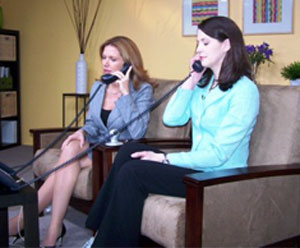
Joy Glen (left) and Diedre Downs (right) during the interviews.
I think the great thing about working with Deidre Downs, Miss America, was that she started wearing our Metrix technology about two years ago, and I have just recently fit her with the Azure hearing aids. She has been, I guess pun intended, "Resoundingly" thrilled with them. I am going out to do another follow-up with her in another week because I like to keep track of her data logging and see what she has been doing.
She said she has never experienced anything like this before. Quite honestly, she would wear her Metrix, I would say, as more of a situational hearing aid, where now she is wearing her Azure 14 hours a day.
I had spent some time with her out in the real world, looking at how the Azure devices work for her. We were at restaurants, a bar, in her classroom at her college where she attends medical school; we had her friends with us. Her friends were coming up to me thrilled because we would be standing in a large group and somebody behind Deidre would say something, and she didn't miss a beat. For the first time in her life she was able to hear everything from all around, and she was comfortable.
So, it has been a real privilege to have fit her and to be a part of her counseling and fine-tuning afterwards, and just to see how it really truly has changed her life. Because as you know, she is a beauty queen, but she is also in medical school. She wants to be a pediatrician, so it is really important for her to be able to hear well.
We are just absolutely honored to have her be a spokesperson. I plan on doing some more public relations events with her this summer, just getting out there into the country and talking about hearing loss and what people can do about it. Maybe we can diminish some of the stigma involved if they see somebody like Miss America who wears hearing aids--BTEs in fact.
Dybala: It has really been a great campaign. If any of the Audiology Online readers would like to find out more, they can visit the ReSound Web Channel here at Audiology Online. There is a news item featuring you, Joy, and Deidre Downs with pictures showing your interviews on TV, and a video clip that shows what was going on. We actually have downloadable recording of the interview that went on the radio, too.
Glen: We have also featured on our Audiology Online Web Channel a video of Deidre's Azure fitting. It shows highlights of my trip to spend the weekend in Birmingham, Alabama with her, at her campus, and to all those restaurants. We actually took a film crew with us and filmed her without the hearing aids and then after she was fit with the Azures.
Dybala: Lot's of great information. The address for the Resound Web Channel on Audiology Online is /channels/gn_resound.asp
Also, we have links to learn more about the Azure. The website is www.tryazure.com to get additional information.
So with that, Joy, thanks for taking time to visit with me today, I think we have covered it all. I look forward to hearing more from Resound in the near future.
Glen: My pleasure, and thank you Paul for interviewing me today!
About ReSound and Azure
For years hearing healthcare professionals like you have been waiting for a breakthrough that solves problems in the real world-not just the lab, ReSound Azure™ is that breakthrough!
We invite you to learn more about the innovations that separate ReSound Azure from the competition, the independent research that supports our claims and how you can begin fitting ReSound Azure today.
Your patients understand benefits-not features. You owe it to yourself to try the first hearing instrument focused on benefits not in some lab, but in the real world.
For more information visit www.tryazure.com or www.audiologyonline.com/channels/gn_resound.asp
References
Cord, M.T., Walden, B.E., Surr, R.K. & Dittberner, A.B. (2007). Field evaluation of asymmetric directional microphone fitting. Journal of the American Academy of Audiology, 18, 245-256.
Dittberner, A.B., Ricketts, T. & Bondy, J. (2006). Analysis of two simulated side-branched compressor strategies and their impact on sound quality perception as a function of hearing impairment. Poster presented at International Hearing Aid Research Conference: Lake Tahoe, California.

